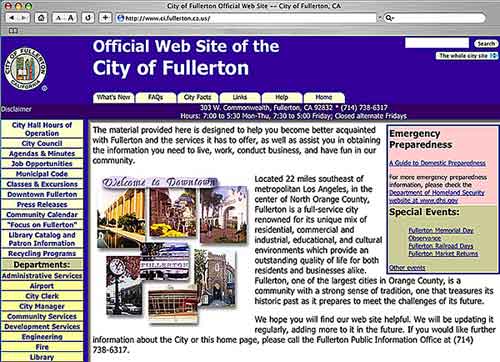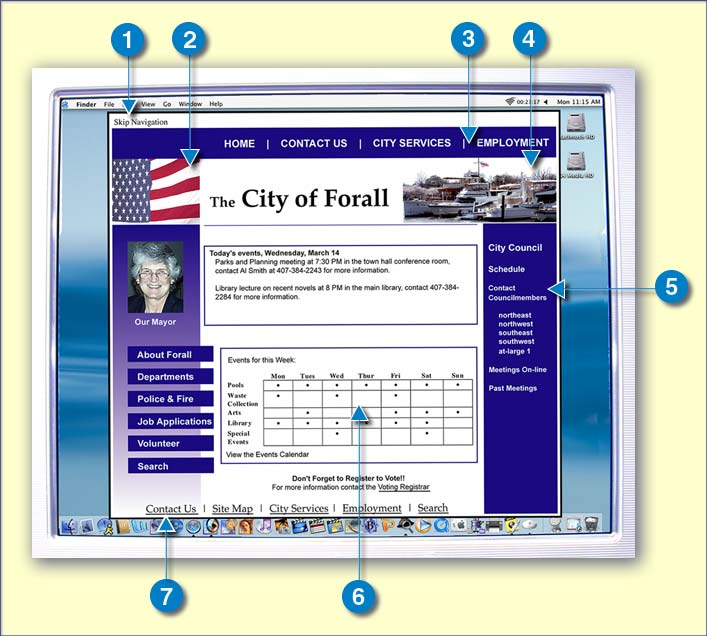|
The Internet is dramatically changing the way that American government serves the public. Taking advantage of new technology, many State and local governments are using the web to offer citizens a host of services including:
- corresponding online with local officials;
- providing information about government services;
- renewing library books or driver’s licenses;
- providing tax information and accepting tax returns; and
- applying for jobs or benefits.
|
These government websites are important because they:
- allow programs and services to be offered in a more dynamic, interactive way, increasing citizen participation;
- increase convenience and speed in obtaining information or services;
- reduce costs in providing programs and information about government services;
- reduce the amount of paperwork; and
- expand the possibilities of reaching new sectors of the community or offering new programs.
|
|
When government is constantly being asked to do more with less, the Internet is playing a vital role in allowing government to better serve all of its citizens.
The Americans with Disabilities Act (ADA) and, if the government entities receive Federal funding, the Rehabilitation Act of 1973, generally require that State and local governments provide qualified individuals with disabilities equal access to their programs, services, or activities unless doing so would fundamentally alter the nature of their programs, services, or activities or would impose an undue burden. One way to help meet these requirements is to ensure that government websites have accessible features for people with disabilities, using the simple steps described in this document. An agency with an inaccessible website may also meet its legal obligations by providing an alternative accessible way for citizens to use the programs or services, such as a staffed telephone information line. These alternatives, however, are unlikely to provide an equal degree of access in terms of hours of operation and the range of options and programs available. For example, job announcements and application forms, if posted on an accessible website, would be available to people with disabilities 24 hours a day, 7 days a week.
Online Barriers Faced By People with Disabilities
Many people with disabilities use “assistive technology” to enable them to use computers and access the Internet. Blind people who cannot see computer monitors may use screen readers – devices that speak the text that would normally appear on a monitor. People who have difficulty using a computer mouse can use voice recognition software to control their computers with verbal commands. People with other types of disabilities may use still other kinds of assistive technology. New and innovative assistive technologies are being introduced every day.
Poorly designed websites can create unnecessary barriers for people with disabilities, just as poorly designed buildings prevent some from entering. Designers may not realize how simple features built into a web page will assist someone who, for instance, cannot see a computer monitor or use a mouse.
One example of a barrier would be a photograph of a Mayor on a town website with no text identifying it. Because screen readers cannot interpret images unless there is text associated with it, a blind person would have no way of knowing whether the image is an unidentified photo or logo, artwork, a link to another page, or something else. Simply adding a line of simple hidden computer code to label the photograph “Photograph of Mayor Jane Smith” will allow the blind user to make sense of the image.
Accessible Design Benefits Everyone
When accessible features are built into web pages, websites are more convenient and more available to everyone – including users with disabilities. Web designers can follow techniques developed by private and government organizations to make even complex web pages usable by everyone including people with disabilities. For most websites, implementing accessibility features is not difficult and will seldom change the layout or appearance of web pages. These techniques also make web pages more usable both by people using older computers and by people using the latest technologies (such as personal digital assistants, handheld computers, or web-enabled cellular phones).
With the rapid changes in the Internet and in assistive technologies used by people with disabilities to access computers, private and government organizations have worked to establish flexible guidelines for accessible web pages that permit innovation to continue.
Resources for Web Developers
To make web pages accessible, the web developer needs to know about web page features that can make a web page less accessible or more accessible. Information about such features is easily available and many software developers are adding tools to web development software to make it easier to make web pages accessible.
Two important resources provide guidance for web developers designing accessible web pages. One is the Section 508 Standards, which Federal agencies must follow for their own new web pages. To learn more about the Section 508 Standards:
- The Access Board maintains information on its website at www.access-board.gov and has a useful guide for web developers at www.access-board.gov/sec508/guide/1194.22.htm;
- The Department of Justice has information about accessible web page design in an April 2000 report to the President. This report is available at www.usdoj.gov/crt/508/report/content.htm, and
- The General Services Administration hosts an online course for web developers interested in accessible web design. This program was developed in conjunction with the Access Board, the Department of Justice, and the Department of Education and provides an interactive demonstration of how to build accessible web pages. This course is available at www.section508.gov, which also provides information about the Federal government’s initiative to make its electronic and information technology accessible to people with disabilities.
A more comprehensive resource is the Web Content Accessibility Guidelines developed by the Web Accessibility Initiative. These guidelines help designers make web pages as accessible as possible to the widest range of users, including users with disabilities. The Web Accessibility Initiative is a subgroup of the World Wide Web Consortium — the same organization that standardizes the programming language followed by all web developers.
- Information for web developers interested in making their web pages as accessible as possible, including the current version of the Web Content Accessibility Guidelines (and associated checklists), can be found at www.w3c.org/WAI/Resources, and
- Information about the Web Accessibility Initiative can be found at www.w3c.org/WAI.
|
Voluntary Action Plan for Accessible Websites
- Establish a policy that your web pages will be accessible and create a process for implementation.
- Ensure that all new and modified web pages and content are accessible:
- Check the HTML1 of all new web pages. Make sure that accessible elements are used, including alt tags, long descriptions, and captions, as needed.
- If images are used, including photos, graphics, scanned images, or image maps, make sure to include alt tags and/or long descriptions for each.
- If you use online forms and tables, make those elements accessible.
- When posting documents on the website, always provide them in HTML or a text-based format (even if you are also providing them in another format, such as Portable Document Format (PDF)).
- Develop a plan for making your existing web content more accessible. Describe your plan on an accessible web page. Encourage input on improvements,
including which pages should be given high priority for change. Let citizens know about the standards or guidelines that are being used. Consider making the more popular web pages a priority.
- Ensure that in-house staff and contractors responsible for web page and content development are properly trained.
- Provide a way for visitors to request accessible information or services by posting a telephone number or E-mail address on your home page. Establish procedures to assure a quick response to users with disabilities who are trying to obtain
information or services in this way.
- Periodically enlist disability groups to test your pages for ease of use; use this
information to increase accessibility.
|
1 Web pages are written using a language called HTML (or “hypertext markup language”). HTML is a “markup language” that tells
a computer program (called a “browser”) how information will appear or will be arranged on a computer screen. HTML
tags are specific instructions understood by a web browser or screen reader. (back)
|
For More Information
Technical Information Regarding Web Accessibility
For technical assistance regarding Section 508 Standards and how to make web pages accessible to people with disabilities, please contact the Access Board:
800-872-2253 (voice)
800-993-2822 (TTY)
Information about the ADA
The Department of Justice provides technical assistance to help State and local governments understand and comply with the ADA. An important source of ADA information is the Department’s ADA Home Page on the World Wide Web. This extensive website provides access to ADA regulations; all Department ADA technical assistance materials, including newly-released publications; proposed changes in the ADA regulations; and access to Freedom of Information Act materials, including technical assistance letters. The website also provides links to other Federal agencies with ADA responsibilities.
In addition, the Department of Justice operates a toll-free ADA Information Line that provides access to ADA specialists during business hours.
ADA Information Line
800-514-0301 (voice)
833-610-1264 (TTY)
Reproduction
Reproduction of this document is encouraged.
June 2003
The Attorney General has determined that publication of this periodical is necessary in the transaction of the public business required by law of the Department of Justice.
The Americans with Disabilities Act authorizes the Department of Justice (the Department) to provide technical assistance to individuals and entities that have rights or responsibilities under the Act. This document provides informal guidance to assist you in understanding the ADA and the Department's regulations.
This guidance document is not intended to be a final agency action, has no legally binding effect, and may be rescinded or modified in the Department's complete discretion, in accordance with applicable laws. The Department's guidance documents, including this guidance, do not establish legally enforceable responsibilities beyond what is required by the terms of the applicable statutes, regulations, or binding judicial precedent.
|
![]()

![]()

